This article was published in Scientific American’s former blog network and reflects the views of the author, not necessarily those of Scientific American
Lagomorphs – that’s rabbits, hares, pikas and their extinct relatives – are often on my mind. In fact one of the most popular and memorable of Tet Zoo articles is the 2006 one in which I denounced rabbits and their kin as “the most freaky of all mammals”. Hyperbole, to be sure, but hyperbole that’s not wholly inaccurate. Lagomorphs have been discussed once or twice at Tet Zoo since then (see the links below). But that’s not nearly enough, I’m sure you’ll agree. Today, let’s look at a few recent developments from the thrilling world of lagomorphs.
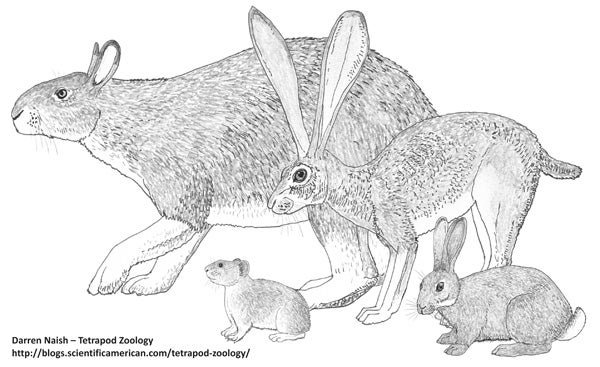
A selection of lagomorphs illustrated for the Tet Zoo Big Book project (on which see here). Nuralagus, Lepus, Ochotona and Oryctolagus. Credit: Darren Naish Tetrapod Zoology
Another extinct island-dweller. Rabbits and kin have a rich fossil record and a substantial number of extinct taxa are known. I provided a cursory discussion of some of this diversity in a previous article otherwise devoted to the large, island-dwelling Nuralagus rex, named in 2011 (Quintana et al. 2011, and see links below). Nuralagus is not the only island-dwelling extinct rabbit we know of. Another is Hypolagus balearicus from the Lower Pliocene of Eivissa and Mallorca in the Balearics, named in 2010. New material of this species has recently been described (Quintana Cardona & Moncunill-Solé 2014).
On supporting science journalism
If you're enjoying this article, consider supporting our award-winning journalism by subscribing. By purchasing a subscription you are helping to ensure the future of impactful stories about the discoveries and ideas shaping our world today.
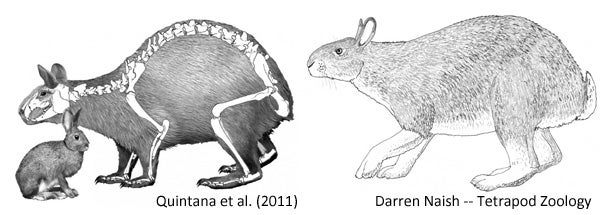
At left: the life reconstruction of Nuralagus, to scale with Oryctolagus (and with its weirdly straight neck skeleton), from Quintana et al. (2011). I have to admit that I'm not that happy with the majority of Nuralagus reconstructions out there; my own life reconstruction - produced for my in-prep textbook project [go here] - is at right. Credit: Darren Naish
H. balearicus is one of about 12 recognised Hypolagus species: Hypolagus is a widespread, long-lived taxon and a lot could be said about it. It’s generally considered closely related to the origin of crown-rabbits and has traditionally been included within the extinct (probably non-monophyletic) group Archaeolaginae.
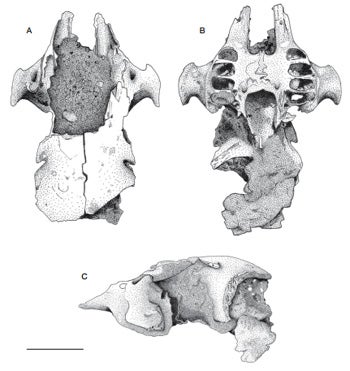
Partial skull of Hypolagus balearicus (A) from above, (B) from below, (C) from the left side. Scale bar = 10 mm. Diagram Credit: Quintana Cardona & Moncunill-Solé 2014
H. balearicus is similar to mainland Hypolagus species in many respects, but its unusual forelimb proportions and joint morphology suggest that – like Nuralagus – it was not a runner, but mostly moved slowly, perhaps inhabiting rocky hillocks or hillsides like those used today by Pronolagus (the African red rock hares) and Caprolagus (the Himalayan hispid hare) (Quintana Cardona & Moncunill-Solé 2014). And in some respects, H. balearicus exhibits parallelisms with respect to what we know of the far more modified Nuralagus.
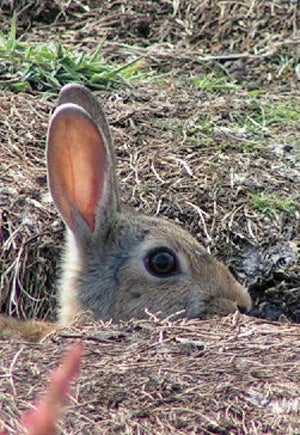
A wabbit! Specifically, Oryctolagus cuniculus. Credit: NORRIE ADAMSON (CC BY SA 2.0)
Rabbits and hares of the Balearics. While on the subject of Balearic rabbits, another recent study (Seixas et al. 2013) looked at the colonisation of Majorca by European rabbits Oryctolagus cuniculus and Iberian hares Lepus granatensis. Genetic diversity in Majorcan populations of both species is high and similar to that of continental populations. This, and other evidence, indicates that both species were introduced to the Balearics on several separate occasions by people for hunting purposes. These introductions occurred at various points within the last 4000 years.
The fact that introduced rabbits have a long and interesting history on the Balearics is reinforced by the existence of an endemic domestic breed: the Ibicenco rabbit or Conill Pagès d’Eivissa. Its precise origins are unknown but it’s a Dutch-style rabbit with a white collar, muzzle and limbs, and a darker body that can be reddish-brown, orange, grey or black. Martín de la Rosa et al. (2016) recently looked at genetic variation within this breed in an effort to maintain viable population size and sustainable breeding stock.
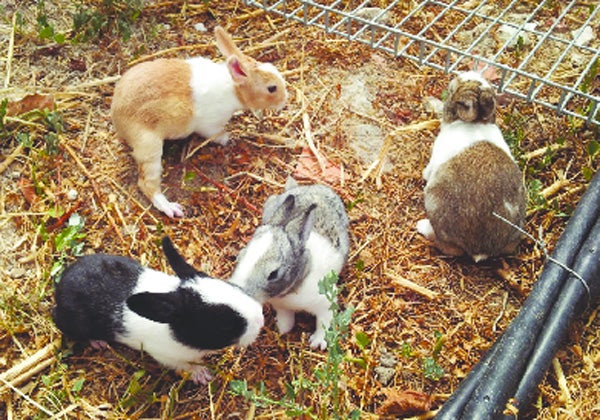
Brown, grey, orange and black varieties of the Majorcan Ibicenco rabbit or Conill Pagès d’Eivissa. Credit: Martín de la Rosa et al. 2016
Incidentally, it’s not clear what any of this means for a legendary rabbit-like beast from Majorca known as the esquirol. Was it merely an ethnoknown version of a lagomorph introduced to the island within the last few thousand years, or something else?
Rabbits: sometime hepatitis reservoirs. A big modern topic that links climate change, anthropological disturbance and ecosystem change is that of emerging diseases. A whole set of virulent microorganisms are seemingly expanding their ranges, infecting new host species, and potentially endangering human life in certain parts of the world. Among these is hepatitis E (HEV), a virus that causes liver inflammation and failure in humans and is mostly spread via contaminated water.
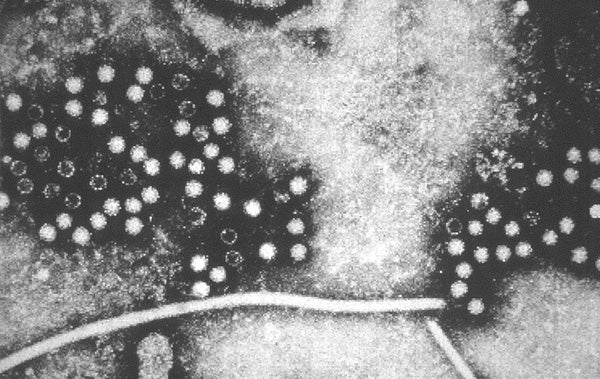
Hepatitis E -- hey, that's no tetrapod! Credit: CDC PHIL #5605
We already know that several HEV strains are zoonotic, since they’ve been transmitted to humans after the ingestion of infected, undercooked boar and deer meat. And HEV seems widespread in mammals, having been identified in cats, mongooses, rats, bison, sheep, goats, cattle, horses and… rabbits. HEV was first identified in rabbits in domestic rex rabbits kept at Gansu. China, in 2009, and was then found to be present in various farmed rabbit breed across China. In 2011, it was discovered in domestic rabbits in Virginia, USA.
One question that immediately arises from this discovery is whether rabbits can transmit the HEV they carry to humans, something that seems likely given that rabbit HEV is closely related to strains known to infect humans. Interested in taking this further, Liu et al. (2013) successfully infected Crab-eating macaques Macaca fascicularis with rabbit HEV. What works for monkeys generally works for humans too (should I court controversy and say ‘non-human monkeys’? [reference]). Several other studies have looked at HEV in rabbits since then (e.g., Han et al. 2014). Infected rabbits suffer from inflamed guts and kidneys as well as liver dysfunction.
Australia: now 60% bunny free! It’s a well known fact of Antipodean mammalogy that European rabbits Oryctolagus cuniculus introduced to Australia initiated one of the country’s most devastating ecological crises. But what’s happened more recently has been cause for optimism, with ecology and native species benefiting tremendously.

Famous photo from the 1930s of Wardang Island rabbits. That's a lot of bunnies. Credit: National Archives of Australia Public Domain
The story goes that rabbit haemorrhagic disease virus (RHDV) – used in experimental fashion on Wardang Island (or Wauraltee Island) off the coast of South Australia – was carried by bushflies to the mainland in 1995, this accidental transmission then spreading through the mainland’s rabbit population. The result was a rabbit decline of about 60%. According to Pedler et al. (2016), this decline is linked to a recovery of vegetation and an unprecedented increase in the populations of several arid-land kangaroos, wombats, dasyurids and native rodents. This recovery among natives is not just due to reduced competition for resources and ecological recovery, but also to a decline in introduced predators (cats and foxes) whose populations were high because of their reliance on rabbits. In other words, both top-down and bottom-up trophic cascades are involved here (Pedler et al. 2016). Most conservation-themed news that comes out of Australia is bad, but what has happened here is a real cause for celebration.
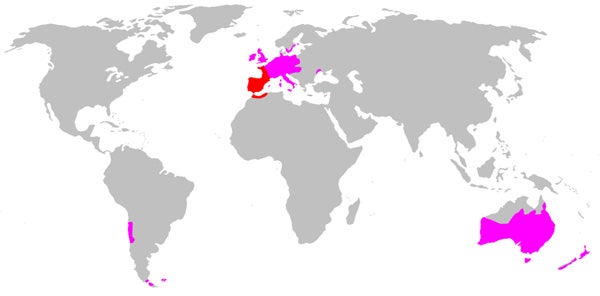
Global range of the European rabbit -- South America and Australasia... what have we done? Credit: CARLOSBLH Wikimedia (CC BY-SA 3.0)
Incidentally, Wardang Island is also the place where myxomatosis was released in field trials in 1937. These proved successful enough that a mainland myxoma virus project occurred throughout the 1950s, effectively reducing the rabbit population by over 80% in just two years.
As usual, there’s much more to say, but that’s all your lagomorphs for now.
For previous Tet Zoo articles on rabbits and kin, see…
Refs - -
Pedler, R. D., Brandle, R., Read, J. L., Southgate, R., Bird, P. & Moseby, K. E. 2016. Rabbit biocontrol and landscape-scale recovery of threatened desert mammals. Conservation Biology doi 10.1111/cobi.12684
Seixas, F. A., Juste, J., Campos, P. F., Carneiro, M., Ferrand, N., Alves, P. C. & Melo-Ferreira, J. 2014. Colonization history of Majorca Island by the European rabbit, Oryctolagus cuniculus, and the Iberian hare, Lepus granatensis (Lagomorpha: Leporidae). Biological Journal of the Linnean Society 111, 748-760.